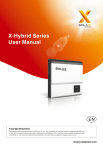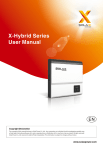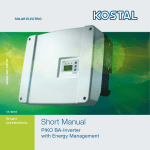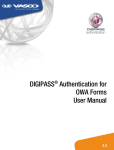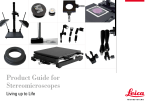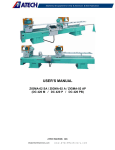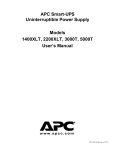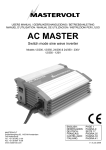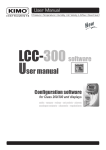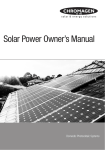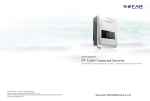Download Sunbank Series User Manual - PHP Version 5.5.9
Transcript
Sunbank Series User Manual Copyright Declaration The copyright of this manual belongs to SolaX Power Co., Ltd. . Any corporation or individual should not plagiarize, partially copy or fully copy it (including software, etc.), and no reproduction or distribution of it in any form or by any means. All rights reserved. SolaX Power Co., Ltd. reserves the right of final interpretation. This information is subject to changes without notice. www.solaxpower.com Contents ................................................................................... 03 SCOPE OF VALIDITY ............................................................................................ TARGET GROUP ................................................................................................... SYMBOLS USED ................................................................................................... 03 03 03 1 NOTES ON THIS MANUAL 1.1 1.2 1.3 .......................................................................................................................... 04 APPROPRIATE USAGE ......................................................................................... IMPORTANT SAFETY INSTRUCTIONS ............................................................... EXPLANATION OF SYMBOLS ............................................................................. EC DIRECTIVES ..................................................................................................... 04 05 06 09 ........................................................................................................ 10 .................................... 10 2 SAFETY 2.1 2.2 2.3 2.4 3 INTRODUCTION 3.1 BASIC FEATURE AND DIFFERENT WORKING MODES 3.2 TERMINALS OF GRID TIED STORAGE INVERTER, GRID TIED INVERTER AND CHARGER ..................................................................................................... 3.3 DIMENSION ......................................................................................................... 3.4 IDENTIFICATION OF SUNBANK ........................................................................ ..................................................................................................... 13 DC INPUT ............................................................................................................. AC OUTPUT .......................................................................................................... BATTERY (FOR THE SK-SU) .................................................................................. EFFICIENCY, SAFETY AND PROTECTION ......................................................... GENERAL DATA ................................................................................................... 13 13 14 14 15 4 TECHNICAL DATA 4 .1 4.2 4.3 4.4 4.5 ............................................................................................................ 15 UN PACKING ........................................................................................................ CHECK FOR TRANSPORT DAMAGE .................................................................. INSTALLATION PRECAUTION ............................................................................ PREPARATION ...................................................................................................... INSTALLATION STEPS ......................................................................................... CONNECTIONS OF THE PV POWER SYSTEM ................................................... RUN THE INVERTER ............................................................................................. 15 16 17 18 19 20 36 5 INSTALLATION 5.1 5.2 5.3 5.4 5.5 5.6 5.7 10 11 12 01 Contents 6 OPERATION METHOD 6.1 6.2 6.3 ........................................................................................ CONTROL PANEL ............................................................................................... LCD FUNCTION ................................................................................................. LCD OPERATION ................................................................................................ 7 TROUBLESHOOTING ........................................................................................... 37 37 38 39 47 7.1 TROUBLE SHOOTING ......................................................................................... 47 7.2 ROUTINE MAINTENANCE .................................................................................. 50 8 DECOMMISSIONING .......................................................................................... 8.1 DISMANTLING THE INVERTER .......................................................................... 8.2 PACKAGING ......................................................................................................... 8.3 STORAGE .............................................................................................................. 8.4 DISPOSAL ............................................................................................................. 9 BATTERY MANAGER ............................................................................................. 9.1 INTRODUCTION ................................................................................................. 9.2 TECHNICAL DATA ............................................................................................... 9.3 CONNECTING ..................................................................................................... 02 51 51 51 51 51 52 52 52 53 Notes on this Manual 1 Notes on this Manual 1.1 Scope of Validity This manual is an integral part of inverter, and it describes the assembly, installation, commissioning, maintenance and failure search of the below inverters. Please read it carefully before operating. SK-TL3000 SK-SU3000 SK-BMU1300 SK-TL3700 SK-SU3700 SK-TL5000 SK-SU5000 Store this manual where it will be accessible at all times. 1.2 Target Group This manual is for qualified electricians. The tasks described in this manual only can be performed by qualified electricians. 1.3 Symbols Used The following types of safety instructions and general information appear in this document as described below: DANGER ! “Danger” indicates a hazardous situation which, if not avoided, will result in death or serious injury. WARNING ! “Warning” indicates a hazardous situation which, if not avoided, could result in death or serious injury. CAUTION ! “Caution” indicates a hazardous situation which, if not avoided, could result in minor or moderate injury. NOTE ! “Note” provides tips that are valuable for the optimal operation of your product. 03 Safety 2 Safety 2.1 Appropriate Usage The SunBank includes a grid-tied PV inverter SK-TL which can convert the DC current of the PV generator into AC current and feed it into the public grid and a grid-tied self-use storage PV inverter SK-SU, which can store the energy in the battery for self-use and also can convert the DC current of the PV generator into AC current and feed it into the public grid. SK-SU inverter PV array DC distribution box Surge arrestor Fuse DC Breaker Surge arrestor Fuse AC Breaker *Fuse AC distribution box *Battery Electric meter, bidirectional Electrical grid Current sensor Public Grid L line CT Note: ﹡For SK-TL series , the fuse and battery are not used. 04 Load Safety Surge protection devices (SPDs) for PV installation WARNING ! Over-voltage protection with surge arresters should be provided when the PV power system installed. The grid connected inverter is not fitted with SPDs in both PV input side and MAINS side. Lighting can cause damage either from direct strike or from surges due to a nearby strike. Induced surges are the more likely cause of lighting damage in majority or installations, especially in rural areas where electricity is usually by long overhead lines. Surge may be included on both the PV array conduction and the a.c. cables leading to the building. Specialists in lighting protection should be consulted during the end use application. Using appropriate external lighting protection, the effect of a direct lightning strike into a building can be mitigated in a controlled way, and the lightning current can be discharged into the ground. Installation of SPDs to protect the inverter against mechanical damage and excessive stress include a surge arrester in case of a building with external lightning protection system (LPS) when separation distance is kept. To protect the d.c. system, surge suppression device (SPD type2) should be fitted at the inverter end of the d.c cabling and at the array, located between the inverter and the PV generator, if the voltage protection level (VP) of the surge arresters is greater than 1100V, a additional SPD type 3 required for surge protection for electrical devices. To protect the a.c system, surge suppression devices (SPD type2) should be fitted at the main incoming point of a.c supply (at the consumer’s cutout), located between the inverter and the meter/distribution system; SPD (test impulse D1) for signal line according to EN 61632-1. All d.c cables should be installed to provide as short runs as possible, and positive and negative cables of the same string or main d.c supply should be bundled together. Avoiding the creation of loops in the system. This requirement for short runs and bundling includes any associated earth/bundling conductors. Spark gap devices are not suitable to be used in d.c circuits as once conducting, they won’t stop conducting until the voltage across their terminals is typically less than 30 volts. 2.2 Important Safety Instructions DANGER ! DANGER TO LIFE DUE TO HIGH VOLTAGES IN THE INVERTER ! • All work on the inverter must be carried out by qualified electrician. • The appliance is not to be used by children or persons with reduced physical sensory or mental capabilities, or lack of experience and knowledge, unless they have been given supervision or instruction. • Children should be supervised to ensure that they do not play with the appliance. 05 Safety CAUTION ! DANGER OF BURN INJURIES DUE TO HOT ENCLOSURE PARTS ! During operation, the upper lid of the enclosure and the enclosure body may become hot. • Only touch the lower enclosure lid during operation. CAUTION ! POSSIBLE DAMAGE TO HEALTH AS A RESULT OF THE EFFECTS OF RADIATION ! • Do not stay closer than 20 cm to the inverter for any length of time. NOTE ! Grounding the PV generator. Comply with the local requirements for grounding the PV modules and the PV generator. SolaX recommends connecting the generator frame and other electrically conductive surfaces in a manner which ensures continuous conduction and ground these in order to have optimal protection of the system and persons. 2.3 Explanation of Symbols This section gives an explanation of all the symbols shown on the inverter and on the type label. Symbols on the Inverter Symbol Explanation Operating Display The battery is in charging or discharging. Communication is active. An error has occurred, please inform your installer immediately. Symbols on the Type Label Symbol Explanation CE mark. The inverter complies with the requirements of the applicable CE guildlines. 06 Safety TUV certified. RCM remark. SAA certification. Beware of hot surface. The inverter can become hot during operation. Avoid contact during operation. Danger of high voltages. Danger to life due to high voltages in the inverter! Danger. Risk of electric shock! Observe enclosed documentation. The inverter can not be disposed of together with the household waste. Disposal information can be found in the enclosed documentation. Don’t work on this inverter until it is isolated from both mains and on-site PV generation suppliers. Danger to life due to high voltage. There is residual voltage in the inverter which needs 5 min to discharge. • Wait 5 min before you open the upper lid or the DC lid. Important Safety Instructions When using the product, please do remember the below information to avoid the fire, lightning or other personal injury: WARNING ! Ensure input DC voltage ≤Max. DC voltage . Over voltage may cause permanent damage to inverter or other losses, which will not be included in warranty! This chapter contains important safety and operating instructions. Read and keep this Operation Guide for future reference. WARNING ! Authorized service personnel must disconnect both AC and DC power from the SunBank Series inverter before attempting any maintenance or cleaning or working on any circuits connected to the SunBank Series inverter. • Read all instructions, cautionary markings on the inverter, and all appropriate sections of this manual before using this inverter. 07 Safety • Use only attachments recommended or sold by SolaX. • Make sure that existing wiring is in good condition and that wire is not undersized. Do not operate the SunBank Series inverter with damaged or substandard wiring. • Do not disassemble the SunBank Series inverter. It contains no user-serviceable parts. See Warranty for instructions on obtaining service. Attempting to service the SunBank Series inverter yourself may result in a risk of electric shock or fire and will void your warranty. • Keep away from flammable, explosive materials to avoid fire disaster. • The installation place should be away from humid or corrosive substance. • Authorized service personnel must use insulated tools when installing or working with this equipment. • PV modules shall have an IEC 61730 class A rating. PE Connection and leakage current • The end-use application shall monitoring of the protective conductor by residual current operated protective device (RCD) with rated fault current Ifn≤240mA which automatically disconnects the device in case of a fault. • DC differential currents are created (caused by insulation resistance and through capacities of the PV generator). In order to prevent unwanted triggering during operation, the rated residual current of the RCD has to be min 240mA. The device is intended to connect to a PV generator with a capacitance limit of approx 700nf. WARNING ! High leakage current! Earth connection essential before connecting supply. • Incorrect grounding can cause physical injury, death or equipment malfunction and increase electromagnetic. • Make sure that grounding conductor is adequately sized as required by safety regulations. • Do not connect the ground terminals of the unit in series in case of a multiple installation. This product can cause current with a d.c component, Where a residual current operated protective (PCD) or monitoring (RCM) device is used for protection in case of direct or indirect contact, only an RCD or RCM of type B is allowed on the supply side of this product. • For Australia and New Zealand: The installation of inverter must fulfill Australia national Wiring rules AS/NZS3000, AS/NZS4777.1 and AS/NZS5033. WARNING ! Do not work on the solar inverter when the device is running. • Never touch either the positive or negative pole of PV connecting device. And never ever touch both at the same time. WARNING ! Risk of electric shock! 08 Safety • The unit contains capacitors that remain charged to a potentially lethal voltage after the MAINS and PV supply has been disconnected. • Hazardous voltage will present for up to 5 minutes after disconnection from power supply. • CAUTION-RISK of electric shock from energy stored in capacitor, never work on the solar inverter couplers. The MAINS cable, PV cables or the PV generator when power is applied. After switching off the PV power and Mains, always wait for 5 minutes to let the intermediate circuit capacitors discharge before you unplug DC input and MAINS couplers. • When access to internal circuit of solar inverter, it is very important to wait 45 minutes before working on power circuit or demounting the electrolyte capacitors inside the device. Do not open the device before hand since the capacitors require this long to discharge sufficiently! • Measure the voltage between terminals UDC+ and UDC with a multi-meter (impedance at least 1Mohm) to ensure that the device is discharged before beginning work (35VDC) inside the device. 2.4 EC Directives This chapter follows the requirements of the European low voltage Directives, which contains the safety instructions and conditions of acceptability for the endues system, which you must follow when installing, operating and servicing the unit. If ignored, physical injury or death may follow, or damage may occur to the unit. Read this instructions before you work on the unit. If you are unable to understand the dangers, warnings, cautions or instructions, contact the manufacture if an authorized service dealer before installing. Operating and servicing the unit. The Grid connected inverter meets the requirement stipulated in Low voltage Directive (LVD) 2006/95/EC and Electromagnetic compatibility (EMC) Directive 2004/108/EC. The unit is tested based on: EN 50178:1997 EN 62109-1:2010 EN 62109-2:2011 VDE 0126-1-1:2006 VDE 4105:2011 In case of installation in PV system, startup of the unit (i.e. start of designated operation) is prohibited until it is determined that the full system meets the requirements stipulated in EC Directive (2006/95/EC,2004/108/EC, etc.) The grid connected inverter leaves the factory completely connecting device and ready for connection to the mains and PV supply. The unit shall be installed in accordance with national wiring regulations. Compliance with safety regulations depends upon installing and configuring system correctly, including using the specified wirings. The system must be installed only by professional assemblers who are familiar with requirements for safety and EMC. The assembly is responsible for ensuring that the end system complies with all the relevant laws in the country where it is to be used. The individual subassembly of the system shall be interconnected by means of the wiring methods outlined in national/international such as the national electric cod (NFPA) No.70 or VDE regulation 0107. 09 Introduction 3 Introduction 3.1 Basic Feature and Different Working Modes The Sunbank storage series including Sunbank grid tied inverter, Sunbank grid tied storage inverter and charger modules. With all these function modules, you can design your own PV self-use storage system as you needed. The self-use system need to be build with either a grid tied inverter, a charger module and a battery system or a grid tied storage inverter and a battery system. We have the below working modes for your home made energy storage system. • Self Use In the “Self Use” mode the priority of the PV generated power will be : local load> battery> public grid. It means the PV generated power will be used in local load then the battery charging and the redundancy power will be delivered to the public grid. • Force Time Use In the “Force Time Use” mode, user can set the charging and discharging time according to his wishes. • No Feed-in. In the “No Feed in “ mode, the priority of the PV generated power is the same as the “Self Use” mode. But it can limit the power to the grid to Zero. 3.2 Terminals of Grid Tied Storage Inverter, Grid Tied Inverter and Charger Grid tied storage inverter (SK-SU) B A C D E F G L I H J K Grid tied inverter (SK-TL) A B C D E F L 10 G K I H Introduction Grid tied inverter (SK-BMU) I H J M Object A B C D E F G H I J K L M K Description DC switch DC connector area Ethernet connector Outside current detect port Communication port for update Communication port for dry contact. Wifi antenna connector Battery connector CAN communication port Battery communication port BUS connector port. AC connector No. of battery group. WARNING ! Only qualified electricians can operate the connection. 3.3 Dimension Dimension for SK-SU series 11 Introduction Dimension for SK-TL series Dimension for SK-BMU series 168mm 514mm 249mm 3.4 Identification of Sunbank Model Name Parameter Series Number Labels Manufacture Info 12 Technical Data 4 Technical Data 4 .1 DC Input Model SK-TL(SU)3000 SK-TL(SU)3700 Max. DC input power (W) 3300 4000 SK-TL(SU)5000 5000 DC input Voltage range(V) 100-550 100-550 100-550 MPP voltage range(V) 125-530 125-530 125-530 Rated input voltage(V) 360 360 360 Start input voltage(V) 100 100 100 Max. DC input current per input (A) 12/12 12/12 12/12 Max. short-circuit current per input (A) 15/15 15/15 15/15 No. of MPP inputs 2 2 2 No. of strings per MPP input 1 1 1 Optional Optional Optional DC Disconnection switch 4.2 AC Output Model SK-TL(SU)3000 SK-TL(SU)3700 SK-TL(SU)5000 Rated output power@ cosφ=1(W) 3000 3680 4600 Max. apparent AC power(VA) 3000 3680 4600 Rated grid voltage(V) 230 230 230 AC voltage range(V) 180~270 180~270 180~270 AC nominal current(A) 13 16 20 Max. output current(A) 14.4 16 22.1 40 40 50 <3% <3% <3% Max. short-circuit current(A) The harmonic factor if output Current at AC THD voltage<2% AC power>0.5 nominal AC power Rated AC frequency(Hz) Rated AC frequency range(Hz) Max. inverter backfeed current to the array 50/60 50/60 50/60 44-55/55-65 44-55/55-65 44-55/55-65 500mA 500mA 500mA Inrush current 60A 60A 60A Maximum output fault current 150A 150A 150A Maximum output overcurrent protection 25A 25A 25A Displacement power factor, adjustable Feed in phase Over voltage category 0.95 overexited...0.95 underexited Single-phase III (electric supply side), II (PV side) 13 Technical Data 4.3 Battery(for the SK-SU) Model SK-SU3000 SK-SU3700 SK-SU5000 Battery Battery voltage (V) 48 Battery voltage range (V) 40-58 Battery type Battery capacity Lead-acid battery/lithium battery 100-120Ah optimized(support external expansion) Battery charger Rated power (W) 1300 Max. charge current (A) 25 Charge efficiency (%) 94 Charging curve 3-stage adaptive with maintenance Battery discharger Rated output power (W) 1300 Max. discharge current (A) 25 Discharge efficiency (%) 94 Discharge depth (%) 80% default Battery voltage sense Yes Current shunt Yes 4.4 Efficiency, Safety and Protection Model SK-TL(SU)3000 SK-TL(SU)3700 SK-TL(SU)5000 Max. Efficiency 97.6% 97.6% 97.6% Euro Efficiency 97.0% 97.0% 97.0% MPPT Efficiency 99.9% 99.9% 99.9% Over voltage/under voltage Protection YES YES YES Safety & Protection 14 DC isolation Impedance YES YES YES Monitoring Ground Fault Protection YES YES YES Grid Monitoring YES YES YES Ground Fault Current monitoring YES YES YES DC Injection Monitoring YES YES YES Back feed current monitoring YES YES YES Residual current detection YES YES YES Anti-island protection YES YES YES Over load protection YES YES YES Over heat protection YES YES YES Installation 4.5 General Data Model SK-TL(SU)3000 SK-TL(SU)3700 SK-TL(SU)5000 Dimension (W/H/D) (mm) 483.5×514×168 (613.5×514×168) Dimension of packing (W/H/D) (mm) 610 x720 x270 (740 x 720 x 270) Weight (kg) 20(27.7) Gross weight (kg) 26(34.7) Cooling concept Forced airflow Noise emission <40 dB Operating temperature range (°C) -10~+50 (derating at 40) Store temperature (°C) -20~+60 Max.permissible relative humidity (non-condensing) 95% Pollution degree II <2000 Altitude (Km) Degree of protection IP20 (for indoor use) Transformer-less Topology <3 Internal consumption (W) LCD display Backlight 16*4 character Communication interface Ethernet/Dry contact /wifi Standard 5 years Standard Warranty 5 Installation 5.1 Unpacking Check the delivery for completeness. Contact your dealer at once if anything is missing. A B C D E F G H 15 Installation I J K M N O Object Quantity A 1 Sunbank series inverter L Description B 1 Bracket C 1 Warranty card D 1 User manual E 4 DC connectors 4 units (2* positive ,2* negative) F 1 AC connector G 1 Screw package 6*expansion screws 6*expansion tubes H 1 8 pin terminal block male connector for dry connector. I 1 Wrench tool for separate DC connector. J 1 Battery connecter . K 1 Current sensor L 1 RJ45 extend port M 1 WIFI antenna N 2 The stopper of the male DC connector O 2 The stopper of the female DC connector Open the package and pick the product, check that if there is any distortion or impaired during the transportation. Meanwhile, check that if the relating accessories and the materials are here, you can see the accessories list in the table. The instruction manual is an integral part of the unit and should therefore be read and kept carefully. It is recommended that the packaging should not be removed until the unit is located in the installation site. 5.2 Check for Transport Damage Check if the SunBank series inverter has some visible external damage , such as cracks in the housing or display please contact with your dealer if you find any damage. 16 Installation 5.3 Installation Precaution The SunBank series inverter is designed for indoor installation (IP20) Make sure the installation site does not fall into none of the following conditions: • • • • • • • • • • • • Do not install the inverter in direct sunlight. Do not install the inverter on flammable construction material. Do not install the inverter in areas where highly flammable materials are stored. Do not install the inverter in potentially explosive areas. Do not install the inverter during periods of precipitation or high humidity (>95%); Moisture trapped within the location may cause corrosion and damage to the electric components. Provide adequate ventilation when using batteries, and also read the warning label on the bottom of the inverter. Install the inverter in a location that maintains an ambient air temperature that is less than 40°C;That is to maintain a safe internal component temperature, the inverter would reduce power if the ambient air temperature exceeds 40°C. The inverter should be installed in a location that is not accessible for children. The inverter emits a slight vibrating noise when operating, which is normal and no effect on performance. The slope of the wall should be within ±5°. The inverter is heavy, ensure the mounting place is strong enough to hold the weight of the inverter. If you install the inverter in a cabinet, closet or other small enclosed area, sufficient air circulation must be provided in order to dissipate the heat generated by the unit. Available Space Size 17 Installation WARNING! Before installation and maintenance, AC and DC side doesn’t carry electricity, but if DC side is just disconnected, capacitance still contains electricity, so please wait for at least 5 minutes to ensure the capacitors completely release the energy and inverter is not electrified. NOTE ! Inverters should be installed by technicians. 5.4 Preparation Below tools are needed before installation. Installation Tools Installation Tools: crimping pliers for binding post and RJ45, screwdriver, manual wrench, ф 6 driller and rubber hammer. Lifting and Handling The unit is heavy. Do not lift it alone. • During lifting procedures ensure that the unit is firmly secured to avoid the risk of accidental tipping or dropping. • Parts serving for support or immobilization of unit shall be designed and manufactured so as to minimize the risk of physical injuries and of accidental loosening of fixing. • Ensure that the method of lifting will not allow the unit to slip from chains and slings or turn-over or slide from lifting devices. • Transportation must be carried by specialized person (truck operators. Hook-up personal), equipped with the necessary protection equipments (overalls, safety shoes, protective gloves, helmets, goggles) • Do not walk or stand beneath or in the proximity of the load. • Avoid sudden movements and jolts when unloading and positioning the unit. Internal handling procedures must be conducted with care. Do not exert leverage on the components of the machine. • If the unit is not balanced apply ballast. Any protruding parts should not be supported by hand. • The inverter should be installed so that the operating panel shall be easily accessible- easy access to the electrical power connection point. • Accessible for maintenance and repair work. • Parts serving for support or immobilization of unit shall be designed and manufactured so as to minimize the risk of physical injuries and accidental loosening of fixings. 18 Installation • Loading capacity and hardness of the supporting surface, load rating of mounting bracket should be at least four times the weight of the devices according to IEC62109-1. and supporting characteristics will be impaired by wear, corrosion, material fatigue or ageing, This should be calculated by inspection of the design data of supporting material and consulting construction engineer. 5.5 Installation Steps Step1: Screw the wall bracket on the wall • Use the wall bracket as a template to mark the position of the six holes. • Drill holes with ф8 driller carefully, make sure the holes are deep enough for install and tight the expansion tubes. • Install the expansion tubes in the wall, and screw the wall bracket using the screws in the screw package. Step2: Hang the Sunbank inverter on the wall bracket. • Transport the inverter needs at least 2 people, each one needs to use the handles at the sides of the inverter. • Hang the inverter onto the bracket, make sure the support in the bracket is fixed with the inverter. 19 Installation Step3: Install the top cover of the inverter. • Put the top cover on the top of the inverter. Fix it well. • Screw the Screw tightly on the both sides of the inverter. Note:The installation of SK-BMU is the same as above. 5.6 Connections of the PV Power System PV String WARNING! PV module voltage is very high which belongs to dangerous voltage range, please comply with electric safety rules when connecting. WARNING! When the photovoltaic array is exposed to light, it supplies a D.C voltage to the PCE. WARNING! When there is something wrong with the modules arrays. Modules can be connected with inverter only after eliminating these problems. SunBank series inverters can be connected in series into 2-strings PV modules. Please select PV modules with excellent function and reliable quality. Open-circuit voltage of module arrays connected in series should be <Max. DC input voltage; Operating voltage should be conformed to MPPT voltage range. Table 3 Max. DC Voltage Limitation Model Max. DC Voltage MPPT voltage range 20 SK-TL(SU)3000 SK-TL(SU)3700 550V 125-530V SK-TL(SU)5000 Installation NOTE! The following requirements of PV modules need to be applied for each input area; • Same type • Same quantity • Identical alignment • Identical Tilt Please use PV cable to connect modules to inverter. From junction box to inverter, voltage drop is about 1-2%. So we suggest the inverter install near PV module, in order to save cable and reduce DC loss. (No longer than 30m) NOTE! Please do not make PV positive or negative ground! • Use multimeter to measure module array voltage • Check the PV+ and PV- from the PV string combiner box correctly.Make sure the PV+ and PV- connected correctly. Connection Step: 1. Disconnection the DC switch. 2. Choose the 12 AWG wire to connect the PV module. 3. Trip 6mm of insulation from the Wire end. 4. Separate the DC connector as below. 5. Insert Striped cable into contact barrel and insure all conductor strands are captured in the contact barrel. 6. Crimp contact barrel by using a crimping pliers. Put the contact barrel with striped cable into the corresponding crimping pliers and crimp the contact. 7. Insert contact cable assembly into back of the male of female insert. When you feel or head a “click” the contact cable assembly is seated correctly. 21 Installation 8. Tight the DC connector. a. Slide the cable nut towards the back shell. b. Rotate the cable nut to secure the cable. 9. After secure the cable tightly, align the 2 half connectors and mate them together by hand until a “click” is felt or heard. 10. Separate the DC connector a. Use the specified wrench tool. b. When separate the DC+ connector, push the tool down from up side. c. When separate the DC- connector. Push the tool down from the bottom side. d. Separate the connectors by hands. WARNING! Before connecting, disconnecting the connection between solar generator and inverter and locked it to the open position during installation. Place a warning sign“do not Turn on maintenance in progress” on the external disconnect switch when it is shut Down, and make sure that on-off remote controls are inhibited. AC Output WARNING! Must comply with the connection requirement of your distribution grid. 22 Installation SunBank series inverters are designed for single phase grid. Voltage range is from 230V according to different countries. The typical frequency is 50Hz. Other technical requests should comply with the requirement of local public grid. For the terminal and cable design please follow below requirements. Terminal capacity and Identification. Connection type Protective earthing connection Torx-head Screw(m5) Rated connecting Tightening capacity and rating torque ----------- 1.8-2Nm Stripping length 11mm DC input connection Amphenol(MC4) 1.8-2Nm ----------- ACoutput connection Amphenol 1.8-2Nm ----------- RS485 Connector ----------- ----------- ----------- Earth conductor: PE screw terminal designed for clamping a cable lug or bar by means of a screw, nut and locking washer, before PE connection, strip the conductor end 12mm long to fit them into a cable lug or bar. For PE connection, the length of conductors between the cord anchorage and the terminal,shall be such that the current-carrying conductors became taut before the earthing conductor if the cable slips out of the cord anchorage. Model SK-TL(SU)3000 SK-TL(SU)3700 SK-TL(SU)5000 Cable(Cu) 4mm 4mm 5mm 20A 20A 25A Micro-Breaker WARNING! Make sure you select the correct specification cables for installation. Otherwise the power will make the cable hot or burnt, it could result in death or series injury Connection Step: 1. Check the grid voltage and compare with the permissible voltage range. (see technical data). 2. Disconnect the circuit-breaker from all the phases and secure against re-connection. 3. Disconnect the AC connector from the inverter. 4. Separate the AC plug into three parts as below. threaded sleele with sealing ring 10-14mm pressure screw socket element 23 Installation 4. Put the threaded sleeve and the pressure screw through the AC wire. pressure screw threaded sleeve green-yellow black blue 5. Wire the AC wire refer to below instructions. a. Screw the green-yellow wire to the ground terminator in the AC connector. b. Screw the blue wire to the N(neutral) terminator in the AC connector. c. Screw the black or brown wire to the L (line) terminator in the AC connector. 6. Confirm all the wires are screwed down. connected wires pressure screw socket element 7. Screw down the threaded sleeve. pressure screw socket element with threaded sleeve 8. Screw down the pressure screw. threaded sleeve pressure screw Selection of Fuse and Cables Mains cable (AC line cable ) shall be short circuit protected and thermal overload protected. 24 Installation Always fit the input cable with fuse. Normal gG(US:CC or T ) fuses will protect the input cable in short circuit situation. They will also prevent damage to adjoining equipment. Dimension the fuses according to local safety regulations. Appropriate input voltage and the related current of the solar inverter. AC output protected by external fuse (gG rated current 20A/250VAC for 3KW and 3.7KW; 25A/250VAC for 5KW) provide in all live connections to the AC supply. The rated short circuit breaking capacity of the above protective device shall be at least equal to the prospective fault current at the point of installation. See section technical data of this manual for details. Ac output cable: Cu, L, N+PE,2*5 .0+5.0mm @40°C ambient with a max length if 5m with operating time of the fuse is less than 5m, with operating time of the fuse is less than 5 seconds, installation method B2 according to EN60204-1:2006, annex D: cable in conduit cable trunking system, number of loaded circuit only one . Use H07RNF (cord designation 60245 IEC66) for an ambient temperature between 40°C and 60°C. Note1: For conditions differing form those mentioned above ,dimension the cables according to local safety regulations, appropriate input voltage and the load and the load current of the unit.( You can choose a thicker cable but the fuses must rated according to the cable.) Note2: Fuses must be approved by notified body. Inverter is not provided galvanic isolation from the mains to the PV array, backfeed current to the array is 20A/250VAC for 3KW and 3.7KW; 25A/250VAC for 5KW, based on the fuse provided in the mains. Also in the worst case .the reverse current comprises the sum of the short-circuit currents of all intact lines. There for the current-carrying capacity of the components and sub-assemblies provided in the end-use system(connectors ,cables, junction box, switch ger,etc.). and the reverse current PV module shall be considered based on the backfeed current and reverse current. The direct current (DC) circuit breaker or fuse between each solar generator and inverter shall be provided based on solar inverter input ratings. Select DC cables based on the above inverter back-feed current and Isc PV rating and Vmax ratings. ● Battery connection (for SK-SU series) When you want to build a self-use storage system , the battery is a necessary part. The Sunbank SK-SU series inverter provide the necessary part of the interfaces to connect the battery to the inverter. WARNING! Make sure you select the correct specification cables for installation. Otherwise the Power will make the cable hot or burnt, it could result in death or series injury. ① The power connection between the battery and the inverter. 1. Connect one side of the battery connect wire to the inverter. 2. Fit a fuse (30A slow blow) in the both positive and negative battery cable as close as possible to the battery. 25 Installation 3. Connect the positive side of the battery connect wire to the positive side of the battery , the negative side of the battery connect wire to the negative side of the battery. 4. Make sure the positive and negative of the battery is correct. ② The communication connection between the battery and the inverter. Communication The communication interface between battery and inverter is RS232 or CAN using a RJ45 connector. The Pin definition is as below. Pin 1 2 Function CANH CANL 3 4 GND RS232_TXD 5 6 7 8 RS232_RXD GND X X Connection steps 1. Prepare RJ45 connectors and a communication cable. 2. Trip the insulation from the communication cable. 3. Insert the communication cable into the RJ45 connector following the PIN definition rule. 4. Crimp the RJ45 connector with the crimping plier. 5. Insert RJ45 side of the cable into the LAN connector on the inverter and connector the other side to the battery. Note: The battery communication can only work when the battery BMS is compatible with the inverter. ● Battery Manager connection( Please refer to section 9) ① The power connection between the inverter and the battery manger. There is power cable in the accessory package of the charger if you bought a battery manager . Connect the cable with the inverter and manager. ② The communication connection between the inverter and the Battery manager There is a communication cable in the accessory package of the manager if you bought a battery manager. Connect the cable with the inverter and manager. ● Current sensor connection The current sensor measure the current on the phase wire that runs between the inverter and the grid. This enables the inverter to determine the Power requirements of the connected consumer. The current sensor is connected to the CT port on the inverter. Connection Step: 1. Insert the RJ45 terminal on the current sensor into the CT port on the inverter. 2. Place the Current sensor around the phase wire L to which the inverter is connected. 3. Place the Current sensor around the phase wire L to measure the Current going to or coming from the grid. 4. Make sure the Current sensor is installed in the right the direction: The arrow on the current sensor must point to the Public grid. 26 Installation SK-SU inverter PV array DC distribution box Surge arrestor Fuse AC Breaker Surge arrestor Fuse DC Breaker *Fuse AC distribution box *Battery Current Electric meter, transformer bidirectional Electrical grid Public Grid Load L line CT When connect the RJ45 connector with the wire of the C T , please follow the below sequence : Pin Function 1 White wire 2 3 4 5 6 7 X X X X X X 8 Black wire 27 Installation NOTE! • Do not place the sensor on the N Wire or the earth wire. • Do not place the sensor on the N and L wire simultaneously. • Do not place the sensor on the L wire going to the consumer. • Do not place the sensor with the narrow pointing to the energy meter. • Do not place the sensor on the non-insulated wires. • Do not place the on a phase other than the one connected to the inverter. • Do not use the wire over 25m. ● Connection the earth of the enclosure. You can additionally earth the inverter enclosure of a second earthing or equipotential bonding is required locally. This prevents touch current if the original protective conductor fails. Cable size: 12AWG. Connection step: 1. Strip the earthing cable insulation. 2. Insert the stripped cable into the ring terminal. 3. Clamp the end of the ring terminal. 4. Unscrew the screw of the earthing connector. 5. Suit the ring terminal on the earthing connector .Suit the gasket on the earthing connector. 6. Screw the the screw of the earthing connector. 28 Installation ● Communication interface This product has a series communication interfaces: such as LAN, Wifi (optional), Dry contact and Extend port and for human and machine communication. Operating information like output voltage, current, frequency, fault information, etc., can be delivered to PC or other monitoring equipment via these interfaces. ① LAN ● Communication LAN communication is one standard communication interface. It transmits the data between the router and SUNBANK series inverters in the local area network. User can set the parameters with specialized software provided by SolaX. The pin definition of the connector as below. Pin 1 2 3 4 5 6 7 8 Function TPTX+ TPTX- 2.5V GND GND 2.5V TPTX+ TPTX- ● Connection steps 1. Prepare two RJ45 connectors and a communication cable. 2. Trip the insulation from the communication cable. 3. Insert the communication cable into the RJ45 connector following the PIN definition rule. 4. Crimp the RJ45 connector with the crimping plier. 5. Repeat the above steps to fix the other head of the communication cable. 6. Insert one side of the cable into the LAN connector on the inverter, and the other side of the cable into the router. ② Wifi Communication ● Communication Wifi communication interface is another standard interface, your can read the real time data in the local net work by your smartphone or check the detail from the internet either from PC or smartphone. ● Connections and setting. 1. You will find an antenna in the accessory package, connect the antenna on the back panel of the inverter. 2. Run the inverter. 3. Network setting. 29 Installation NOTICE! The setting hereinafter is operated with Window XP for reference only. If other operating systems are used, please follow the corresponding procedures. (1). Prepare a computer or device with WiFi. E.g tablet PC and smartphone, that enbales WiFi. (2). Obtain an IP address automatically. ① Open Wireless Network Connection Properties, double click Internet Protocol (TCP/IP). ② Select Obtain an IP address automatically, and click OK. 30 Installation (3). Set WiFi connection ① Open wireless network connection and click View Wireless Networks. ② Select wireless network of the data logging module, no passwords required as default. The network name consists of AP and the serial number of the product. Then click Connect. ③ Connection successful. 31 Installation NOTICE! If AP_(series number of product ) is not available in the wireless network list, there may be problems in the connection or setting of the inverter . Please reconnect it again. (a) Open a web browser, and enter 10.10.100.254, then fill in username and password, both of which are admin as default. Recommended browsers: Internet Explorer 8+, Google Chrome 15+, Firefox 10+ admin admin (b) In the configuration interface of WiFi, you can view general information of the data logger. Follow the setup wizard to start quick setting. ① Click Wizard to start. ② Click Start to continue. 32 Installation ③ Select Wireless connection, and click Next. ④ Click Refresh to search available wireless networks, or add it manually. 33 Installation ⑤ Select the wireless network you need to connect, then click Next. NOTICE! If the signal strength (RSSI) of the selected network is <10%, which means unstable connection, please adjust the antenna of the inverter, or use a repeater to enhance the signal. ⑥ Enter the password for the selected network, then click Next. ⑦ Select Enable to obtain an IP address automatically, then click Next. 34 Installation ⑧ If setting is successful, the following page will display. Click OK to restart. ⑨ If restart is successful, the following page will display. 35 Installation 1. Monitor in the local net work. (1) Down load an APP and install in the smartphone. (2) Open the APP with the “offline” mode. (3) After select the right WIFI, you can read the real time information of the inverter on your phone. 2. Monitor via internet on the Web. (1) Open the Website and Register as a customer. (2) Login in with the Email and password you registed. (3) The user can read the information and history data on the website. 3. Monitor via APP. (1) Down load a APP and install in the smartphone. (2) Open the APP with the “online” mode. (3) You can read the information and history data if your phone is connected with the internet. Note: Download App at http://www.solarmanpv.com/zh-cn/mobileapp.html. Register at http://www.solarmanpv.com/portal/LoginPage.aspx. Dry contact ● Communication Dry contact is provided to give a remote monitor and remote control with the optional accessory. The remote monitor function provides an indication on the inverter's working status. The remote control function provides a contact signal to operate the inverter. The dry contact communication use terminal blocks. The PIN definitions and the circuit connection are as below. Pin Definition 1 2 3 4 5 Remote control for reactive power regulation 6 7 8 Remote monitor Note: The external connection of PIN7 and PIN 8 must within the range of 300V 2A. ● Connection steps 1. Choose at least 16mm2 wire. Trip the insulation from the wire ends. 2. Insert the tripped wire into the hole of the terminal block. 3. Screw down the screws on the terminal block. 5.7 Run the inverter Start inverter after checking all below steps: • Check that the device is fixed well on the wall. • Make sure all the DC wirings and the AC wirings are completed. 36 Operation Method • • • • Make sure the CT is connected well. Make sure the battery is connected correctly. Turn on the external AC and DC connector. Turn on the DC switch to the “ON” position. Start inverter • Inverter will start automatically when the PV panel generate enough energy or the battery is charged. • Check the status of LED and LCD screen, the LED should be green and the LCD screen should display the main interface. • If the LED is not green, please check the below: - All the connections are right. - All the external disconnect switches are closed. - The DC switch of the inverter is in the “ON” position. • Enter the setting interface. • Set the safety standard as page41. • Set the system time as page 42. • PV connection mode as page 42 . • Set the work mode as page 44 • Set battery as page 45. • Set the ethernet or WIFI as page 46 or page 32. . WARNING! Power to the unit must be turned on only after installation work has been completed. All electrical connections must be carried out by qualified personnel in accordance with legislation in force in the country concerned. NOTE ! Please set the inverter if it is the first time to start up. Above steps is for the regular start up of the inverter. If it is the first time to start up the inverter, you need to setup the inverter . 6 Operation Method 6.1 Control Panel I H A B C D OK G ESC F E 37 Operation Method Object Name A B Indicator C LED D Yellow: Communication status. Down button: Move cursor to downside or decrease value. F Function G Button H ESC button: Leave from current interface or function. OK button: Confirm the selection. Up button: Move cursor to upside or increase value. LCD Screen 6.2 LCD Function Menu structure 38 Blue: Battery charging or discharging. Red: Error. E I Description Green: Normal working status. Display the information of the inverter. Operation Method 6.3 LCD Operation ● LCD Digital Display The main interface is the default interface, and the inverter will automatically jump to this interface when the system started up successfully or not operated for a period of time. The information of the interface is as below. The “Power” means the timely output power; “Today” means the power generated within the day. “Battery” means the left percentage of battery energy. “Normal”show the status of the inverter. Power 0W Today 00.0KWh Battery % Normal ● Menu interface The menu interface is a transfer interface for user to get into the other interface to finish the setting or to get the information. - User can get into this interface by pressing the “OK” button when the LCD displays the main interface. - User can select interface by moving the cursor with the function button, and press “OK” to confirm. MENU Status History Setting ● Status The status function contains three aspects of the inverter, the grid , solar and the battery. Press up and down to select and press “OK” to confirm the selection, press “back” to return to the Menu. Status Grid Solar Battery A) Grid status This status shows the current grid condition such as voltage, current, output power and the local consumed power . Press up and down button to review the parameter. Press “back” to return to Status . Grid V I P 000.0V 00.0A 00.0W 39 Operation Method B) Solar status This status shows the current PV condition of the system. The input voltage, current and power situation of every PV input. Press up and down button to review the parameter. Press “back” to return to Status . Solar V1 I1 P1 360.0V 1.0A 360W C) Battery status This status shows the battery situation of the system. Include the battery voltage, charge or recharge current. Charge or recharge power, battery capacity and battery temperature. It can show 4 groups of battery. “+” means in charging; “-” means in recharging. Press up and down button to review the parameter. Press “back” to return to Status. Battery V1 I1 P1 54.0V +1.0A +54W ● History The history function contains three aspects of the information: Yield, consume and error log. Press up and down to select ,and press “OK” to confirm the selection, press “back” to return to the Menu. History Yield Battery Yield Error Log D) Yield The yield function contains the energy generated by today, yesterday , last 7 days, this month and last month. Press up and down button to review the parameter. Press “back” to return to History . Yield >Today: 00.0KWH E) Local Yield The Local Yield function contains the energy consumed from the grid by today, yesterday, last 7days , this month and last month. Press up and down button to review the parameter. Press “back” to return to History . 40 Operation Method Battery Yield >Today: 00.0KWH F) Error log The Error log contains the error information happed, Which can record for three items. Press up and down button to review the parameter. Press “back” to return to History . Error log > No error ● Settings Setting function is used for setting the inverter for time, connection, battery, Ethernet, Grid and so on. Since this function will change the inverter’s parameter, We need password to enter. Setting Safety Date time Connection G) Password The default password is “0000” for end user, For the installer password, please contact with the distributer or factory. we need to increase or decreased the word by press up or down button. Press “OK” to confirm and alternate to the next word. After all when the word is confirmed. Press “OK” to enter the password. Password 0 0 0 0 H) Safety The user can set the safety standard here. According to different country and grid tied standard. There is 8 standard for choice. Item Standard 1 2 3 4 5 VDE0126 EN50438_DK EN50438_NL E8001 C10/C11 6 7 8 G83 AS4777 ARN4105 Country German Danmark Netherland Austria Belgium England Australia German Safety > country VDE0126 41 Operation Method I) Date time This interface is for user to set the system date and time. Increase or decreased the word by press up or down button. Press OK to confirm and alternate to the next word. After all the word are confirmed. Press “OK” to enter the date and time. Date time 2013 >06 <06 10 19 J) New Password You can set your new password here. We need to increase or decreased the word by press up or down button. Press “OK” to confirm and alternate to the next word. After all the words are confirmed. Press “OK” to reset the password. Password 1 2 3 4 K) PV Connection This function can set the mode of PV input. There are two modes for choice: Comm and Mul. The “Comm” mode mean single MPP tracking; “Mul” means multi-MPP tracking. Press up or down button to select and press “OK” to confirm. PV Connection PV Connection Comm L) Power factor( For specific country if required by the local grid) User can set the power factor here. There is 4 modes for select: OFF, Ind, Cap, Curve. Select “off” to shut off this function; Select “Ind” to set the inductive power factor; Select “Cap” to set the capacitive power factor ; Select “Curve” to set the power factor including “upper limit”, “Lower limit”,” power upper” and “power lower” according to below curve. All the setting can set the parameter from 0.00 to 1.00. Cosφ Over Excited Upper Limit 0.90 Power Upper 0.70 Lower Limit 0.90 42 Under Excited 1 0.30 Power Lower Operation Method Power factor >Mode select Off M) Power limit User can set the output power limitation here, the setting value is from 0.00-1.00. Power Limit >Proportion 0.00 N) Grid Usually user do not need to set the parameters here, as when you select the safety the default value will be used according to the safety rules. The parameters here is described as below. If need to reset, please contact with your installer. Any changes should according to the requirement of the local grid. Press up or down button to select and press “OK” to confirm. Grid >Vac Upper 000.0 43 Operation Method O) Work mode The default work mode of the inverter is Self Use mode. User can setting the work mode as Self Use , Force Time Use and No feed in here as describe in 3.1. For the Force Time Use. User can set 2 periods of the start and end time of charger or discharge. Also can select if chargeing from grid. Work Mode >Mode Select Force time use Work Mode >Charge From Grid Disable Work Mode > Parameter 44 Charge Start time 1 08:00 Comment Charger start time1 Charger end time1 The start time of the rst charger period. Charger start time2 The start time of the second charger period. The end time of the rst charger period. Charger end time2 The end time of the second charger period. Discharger start time1 The start time of the rst discharger period. Discharger end time1 The end time of the rst discharger period. Discharger start time2 The start time of the second discharger period. Discharger end time2 The end time of the second discharger period. Operation Method P) Battery The inverter is compatible with Lead acid and lithium batteries, and can support up to 4 external BMU. Users can set the battery type, charge and discharge parameters here. Press up or down button to select and press“OK” to confirm. For the detailed parameters , please refer to below table. Battery >Set battery 1 Set battery 2 Battery >Battery type Lead Acid Battery1 >Min Capacity 20% Parameter Min capacity Comment The remaining capacity of the battery, refer to the DOD of the battery as suggested by the supplier. Charge cut voltage When the battery voltage reached this value , the BMU will stop to charge the battery. Discharge cut voltage When the battery voltage reached this value , the BMU will stop to discharge the battery. Charge max current The charge current can be set for 0-25A. The charge power can also be set. Discharge max current The discharge current can be set for 0-25A. The charger power can also be set. Note: The “Min capacity” is only available when the battery have communication with the BMU. 45 Operation Method Q) Ethernet Users can set the information about Ethernet here , such as IP address, subnet mask number, and default gateway number. Press up or down button to select and press “OK” to confirm. Ethernet > IP Address 000.000.000.000 R) Reset energy User can reset the energy record here. Press up or down button to select and press “OK” to confirm. Reset energy Whether Reset No S) Reset error log User can reset the error log here. Press up or down button to select and press “OK” to confirm. Reset error log Whether Reset No ● About This interface shows the information of the inverter , Such as series numbers, and software version. About SN 01234567890123456789 46 Troubleshooting 7 Troubleshooting 7.1 Trouble Shooting This section contains information and procedures for solving possible problems with the SUNBANK series inverters, and provides you with trouble shooting tips to identify and solve most problems that could occur with the SUNBANK series inverters. This section will help you narrow down the source of any problem you may encounter. Please read the following troubleshooting steps. • Check the warning or fault messages on the System Control Panel or Fault codes on the inverter information panel. If a message is displayed, record it before doing anything further. • Attempt the solution indicated in below table. Faults Diagnosis and solution SPI Fault SPI communication fault • Disconnect PV+ , PV- and battery, reconnect them. • Or seek help from us, if can not go back to normal state. SCI Fault SCI communication fault • Disconnect PV+ , PV- and battery, reconnect them. • Or seek help from us, if can not go back to normal state. CAN1 Fault CAN communication fault • Disconnect PV+ , PV- and battery, reconnect them. • Or seek help from us, if can not go back to normal state. PV Config Fault PV Connection Setting Fault • Resetting the PV connection • Or seek help from us, if can not go back to normal state. Inv EEPROM Fault Inverter EEPROM fault • Disconnect PV+ , PV- and battery, reconnect them. • Or seek help from us, if can not go back to normal state. Relay Fault Relay Fault • Disconnect PV+ , PV- and battery, reconnect them. • Or seek help from us, if can not go back to normal state. Sample Fault The detection circuit Fault • Disconnect PV+ , PV- and battery, reconnect them. • Or seek help from us, if can not go back to normal state. RCD Fault Fan1 Fault Fan2 Fault Residual Current Device Fault • Check the impedance of DC input and AC output. • Disconnect PV+ , PV- and battery, reconnect them. • Or seek help from us, if can not go back to normal state. Fan Device Fault • Disconnect PV+ , PV- and battery, reconnect them. • Check if the fan is stopped by dust or other foreign. • Or seek help from us, if can not go back to normal state. 47 Troubleshooting Faults AC HCT Fault DC1 HCT Fault DC2 HCT Fault DC Current sensor Fault • Disconnect PV+ , PV- and battery, reconnect them. • Or seek help from us, if can not go back to normal state. DCI Fault DCI Device Fault • Disconnect PV+ , PV- and battery, reconnect them. • Or seek help from us, if can not go back to normal state. TZ Protect Fault Over current fault. • Wait for a while to check if go back to normal status. • Disconnect PV+ , PV- and battery, reconnect them. • Or seek help from us, if can not go back to normal state. Grid Lost Fault Grid is lost. • System will reconnect if the utility is back to normal. • Or seek help from us. Grid Volt Fault Grid Voltage out of range • System will reconnect if the utility is back to normal. • Or seek help from us. Grid Freq Fault Grid Voltage out of range • System will reconnect if the utility is back to normal. • Or seek help from us. PLL Lost Fault The grid is not good. • System will reconnect if the utility is back to normal. • Or seek help from us. Bus Volt Fault 48 Diagnosis and solution AC Current sensor Fault • Disconnect PV+ , PV- and battery, reconnect them. • Or seek help from us, if can not go back to normal state. Bus Voltage out of normal range. • Disconnect PV+ , PV- and battery, reconnect them. • Check if the PV input is within the range of the inverter. • Or seek help from us, if can not go back to normal state. AC5M Volt Fault The grid's Voltage is out of range for the last 5 Minutes. • The system will back to normal if the grid is back • Or seek for help from us. Inv OCP Fault Inverter over current protection Fault • Wait for a while to check if back to normal. • Or seek for help from us. DCI OCP Fault DCI over current protection Fault. • Wait for a while to check if back to normal. • Or seek for help from us. RC Fault DCI over current protection Fault. • Wait for a while to check if back to normal. • Or seek for help from us. Troubleshooting Faults Diagnosis and solution PV Volt Fault PV Voltage Fault • Check the output of the PV voltage. • Or seek for help from us. AC10M Volt Fault The grid's Voltage is out of range for the last 10 Minutes. • The system will back to normal if the grid is back • Or seek for help from us. Isolation Fault Isolation Fault • Check the connection of the inverter. • Or seek for help from us. Temp Over Fault Fan1 Speed Fault Fan2 Speed Fault Temperature Over the limitation • Check if the fan is running normally. • Check if the envirement temperature is over limitation.\ • Or seek help from us. Fan Speed out of the normal range. • Check if the fan is stopped by dust or other foreign. • Or seek help from us, if can not go back to normal state. C1 -C5 Can Fault The battery group's Can communication Fault. • Reconnect the charger communication cable. • Or seek help from us. C1-C5 Temp High The battery charger is over temperature. • Check if the air ducting of the charger is blocked. • Improve the working environment or reduce the charging or discharging current. • Or ,Seek help from us. C1-C5 FAN Fault The Fan of the charger is broken. • Check if the fan is working normally. • Check if anything blocking the fan • Or, Seek help from us. C1-C5 TZ Fault The protection of the charger fault. • Wait for a while to check if back to normal. • Or, Seek help from us. C-C5 EEPROM Fault The charger's EEPROM fault. • Wait for a while to check if back to normal. • Or, Seek for help from us. C1-C5 HCT Fault The charger's current detection fault. • Reconnect the charger. • Or, Seek for help from us. C1- C5 Bus OVP The Bus voltage of the charger over limit. • Wait for a while to check if back to normal. • Or, Seek for help from us. C1-C5 Temp Low The charger is under temperature • Improve the working environment of the charger. • Or, Seek for help from us. 49 Troubleshooting Faults Diagnosis and solution C1-C5 Boost OVP The Boost voltage of the charger over limit. • Wait for a while to check if back to normal. • Or. Seek for help from us. C1-C5 Bat OVP The battery voltage is over limit. • Wait for a while to check if back to normal. • Or, Seek for help from us. C1- C5 Charger OCP C1-C5 Boost OCP The charger is over current protected. • Wait for a while to check if back to normal. • Or, Seek help from us. The boost current of the charger is over limit. • Wait for a while to check if back to normal. • Or, Seek help from us. If your inverter's information panel is not displaying a Fault light, check the following list to make sure that the present state of the installation allows proper operation of the unit. • Is the inverter located in a clean, dry, and adequately ventilated place? • Have the DC input breakers been opened? • Are the cables adequately sized and short enough? • Are the input and output connections and wiring in good condition? • Are the configurations settings correct for your particular installation? • Are the display panel and the communications cable properly connected and undamaged? Contact SolaX Customer Service for further assistance. Please be prepared to describe details of your system installation and provide the model and serial number of the unit. 7.2 Routine Maintenance ● Inverter Inverters need to be checked every 12 months . (once per year) Clean the housing with a dry cloth and check that there is no airflow obstruction. Remove any dust build-up from the locations as indicated. Check the inverter and the cables for visible external damage on regular basis. WARNING! Clean the airflow holes inside the housing, and cut off the power from the inverter by decommissioning or by using a bypass switch. Internal cleaning is only to be carried out by certified persons. Contact your installer/dealer if you find any defects. Do not perform any repair work by yourself. 50 Decommissioning ● Battery The SUNBANK series inverter compatible with both lid-acid and lithium battery. Either type of the battery needs to be maintained every month /quarter/ year according to different types and requirement of the battery. If the capacity of the battery decreased to lower than 80% of the rated capacity, the battery should be replaced. NOTE ! The chapter is only for reference. The exact maintenance should be according to the guilds provided by the battery manufacture. 8 Decommissioning 8.1 Dismantling the Inverter • • • • • Disconnect the inverter from DC Input and AC output. Disconnect battery wirings. Wait for 5 minutes for de-energizing. Disconnect communication and optional connection wirings. Remove the inverter from the bracket. 8.2 Packaging If possible, please pack the inverter with the original packaging. If it is no longer available, you can also use an equivalent cartoon that meets the following requirements. • Suitable for loads more than 25 kg. • With handle. • Can be fully closed. 8.3 Storage Store the inverter in dry place where ambient temperatures are always between -20 °C - +60 °C. 8.4 Disposal When the inverter or other related components need to be disposed. Have it carried out according to local waste handling regulations. Please be sure to deliver wasted inverters and packing materials to certain site, where can assist relevant department to dispose and recycle. 51 Battery Manager 9 Battery Manager 9.1 Introduction The Sunbank battery manager can be used with SK-TL or SK-SU series inverter for extending the battery capability of self use, Max to 4 battery manager for one inverter (including the internal one for SK-SU series) 9.2 Technical Data Model SK-BM1300 Battery Battery voltage (V) Battery voltage range (V) Battery type Battery capacity 48 40-58 Lead-acid battery/lithium battery 100-120Ah optimized(support external expansion) Battery charger Rated power (W) Max. charge current (A) Charge efficiency (%) Charging curve 1300 25 94 3-stage adaptive with maintenance Battery discharger Rated output power (W) 1300 Max. discharge current (A) 25 Discharge efficiency (%|) 94 Discharge depth (%) 80% default Battery voltage sense Yes Current shunt Yes General data Dimension (W/H/D) (mm) Dimension of packing (W/H/D) (mm) Weight (kg) 380×720×270 11.5 Gross weight (kg) 12.5 Cooling concept Forced airflow Noise emission Operating temperature range (℃) Store temperature (℃) Altitude (Km) Degree of protection 52 253.7×514×168 <40 dB -20∼+50 (derating at 40) -20∼+60 <2000 IP20 (for indoor use) Battery Manager 9.3 Connecting ● Connect the SK-SU with the SK-BMU ● Connect the SK-TL with the SK-BMU ● Expand the SK-BMU ● Set the DIP switch on the SK-BMU. We need to set the DIP switch to identify the expanded BMU. For SK-SU, the internal BMU is recognized as C1, the expended BMU is recognized from C2-C4. For SK-TL, the expended BMU begins from C2, and the last should be set as C1. DIP switch means “0" when on the up position; means “1" when on the low position. 7 8 Note: For SK-SU, the expended BMU can not set as C1(DIP:11) which can not be recognized. 53 Battery Manager 54 SolaX Power Co,. Ltd. No.288 Shizhu Road, Tonglu Economic Development Zone, Tonglu City, Zhejiang province, China. Tel: +86 0571-58509376 E-mail: [email protected] www.solaxpower.com 614.00020.00

























































